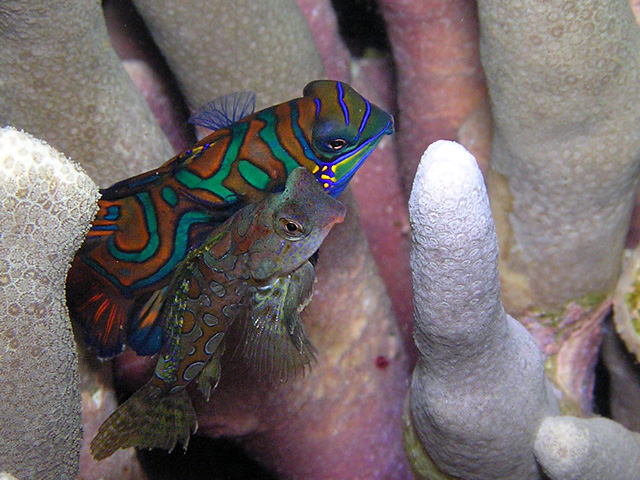The mandarins and scooters in the genus Synchiropus are among some of the most endearing and staple favourites in the aquarium hobby. Mandarins are especially colourful, and their crawling like behaviour coupled with their unorthodox appearance makes for some of the dare we say, cutest, fish out there. Although famed for their difficulty and reluctance to feed, the dragonets in recent years have seen promising ventures such as successful captive breeding efforts by ORA, with S. picturatus attaining an average of 90-98% survival rate per batch.

Of the four species of “mandarins” within the Synchiropus genus, only S. splendidus and S. picturatus are easily available. Synchiropus occidentalis from Western Australia is extremely rare and expensive, and after making a brief appearance awhile ago has vanished again without so much of a trace. The other “mandarin” is Synchiropus circularis, and like S. occidentalis, is very rarely encountered in the trade. Although they can be found in the Philippines, their cryptic and mute coloration along with their undetermined range protects them from much collection. S. circularis is also unique in its appearance, looking like an intermediate between a mandarin and a scooter.

Photos and information of S. circularis are scarce, and the few pictures out there are taken by dedicated Japanese divers. Very interestingly though, these few images show S. circularis engaging in spawning activities with S. splendidus over coral heads in Anilao, Philippines. We consulted with Dustin Dorton of ORA with regards to interspecific hybrids of Synchiropus. According to Dustin, they have had S. splendidus spawning with S. picturatus, but the eggs were non-viable and development stopped after the fourth cell division.
Based on the circumstances of S. splendidus x S. picturatus, it is highly possible that S. splendidus x S. circularis would also result in sterile eggs. It is also noteworthy that no hybrid mandarin fishes have ever been documented, as far as we know. Despite the odds stacked up against these two species, it seems as though they are deliberately spawning together. There are many of such photos and it does not seem to be a one off coincidental occurrence.

It is not uncommon for interspecific hybridisation to occur. However in such cases, one species would usually have to be very rare, and the difficulty in finding a mate of the same species would drive it to spawn with another in a similar complex. There are many examples, and a well known one involves Centropyge ferrugata and C. loricula in the Philippines. At that location, C. loricula is very rare while the closely related C. ferrugata is abundant. This forces C. loricula to hybridise with C. ferrugata in the event where finding a similar mate is difficult. Centropyge multicolour in Philippines faces the same problem, and have been known to hybridise with C. ferrugata as well as C. bispinosa in that area.

We don’t know the abundance of S. circularis and S. splendidus in their overlapping range, but based on photos and videos it would seem that neither species are rare, or rare enough to warrant frequent interspecific pairing. In the photo above a regular spawning accent between two sexes of the same species (S. circularis) takes place above a head of Porites. The prevalence of many spawning pairs should indicate a roughly healthy and abundant population.
It seems therefore strange why two species that are neither rare nor viable would intentionally come together during spawning rituals. In the *third photo above you see that a pair of S. circularis in spawning accent is interrupted by an intruding S. splendidus resulting in a threesome of sorts.

What’s also interesting is that there appears to be two colour forms of S. circularis. A duller more brownish form and another with a more reddish hue. S. splendidus also occurs in two colour forms, a red and a blue form. Dustin from ORA shared with us that in pairs of red x red mandarins, the resulting offspring would all consist of red babies, while pairs of blue x blue would result in offspring consisting 100% of blue babies. Interestingly, red x blue or blue x red pairs yield the same “hybrid” offspring, with traits of both colour forms. Although some may be difficult to distinguish from a regular blue mandarin fish, some have apparent red streaks showing up on an otherwise blue pelvic fin.

Due to the lack of photographic documentation and lack of breeding evidence in S. circularis, it is unknown whether the two colour forms are breeding, or if they are indeed distinct colour forms in the first place. What we do know is that despite having enough mates around to choose from, these two species are more often than not seen spawning together. Due to the lack of evidence suggesting successful crossing, and also with ORA’s experience with regards to S. splendidus x S. picturatus, it is likely that hybrids are not viable.
Regardless, it is nice just to ponder over nature’s many fanciful ideas. The video below shows a pair of S. splendidus and a pair of S. circularis, spawning right at the same time. At the thirteen second mark, both pairs of species make their ascent as the exact same time. Now that’s cool, even if no interspecific hanky panky was involved.



